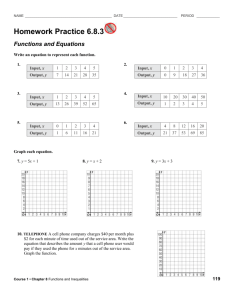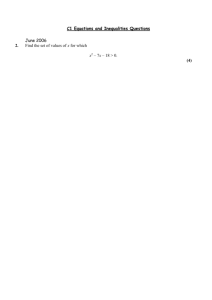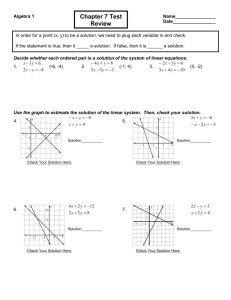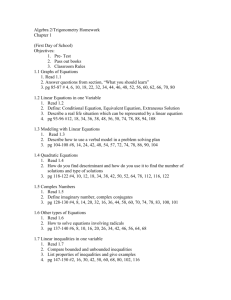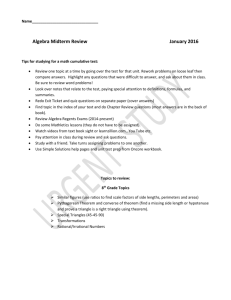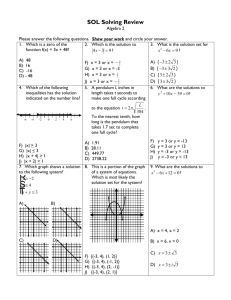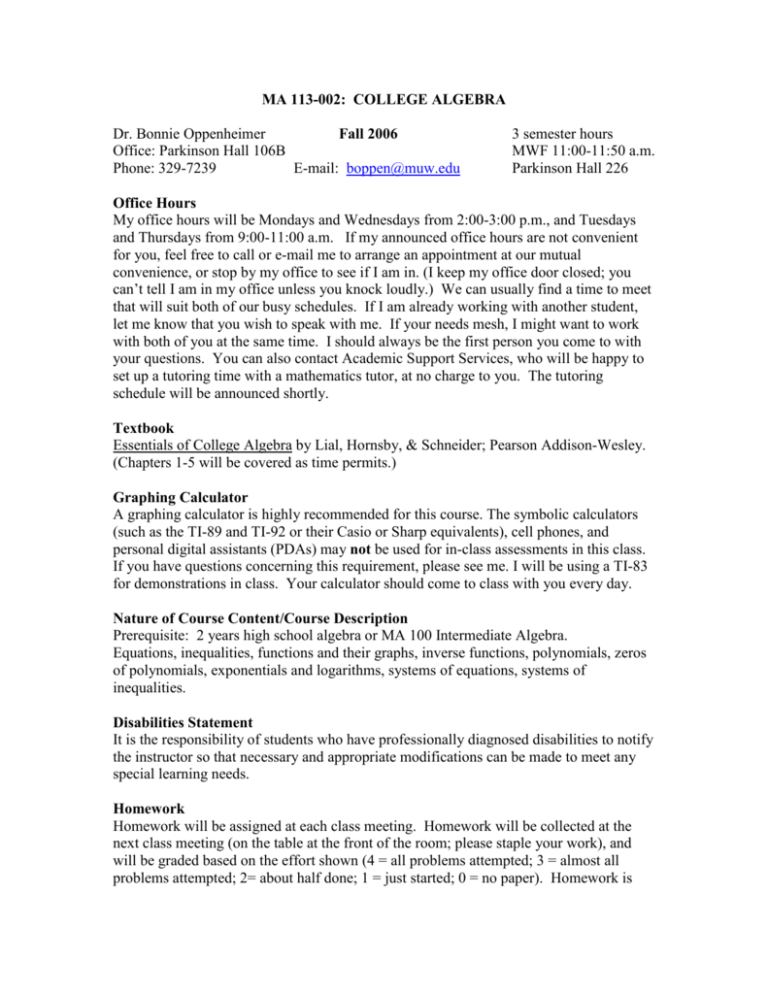
MA 113-002: COLLEGE ALGEBRA
Dr. Bonnie Oppenheimer
Fall 2006
Office: Parkinson Hall 106B
Phone: 329-7239
E-mail: boppen@muw.edu
3 semester hours
MWF 11:00-11:50 a.m.
Parkinson Hall 226
Office Hours
My office hours will be Mondays and Wednesdays from 2:00-3:00 p.m., and Tuesdays
and Thursdays from 9:00-11:00 a.m. If my announced office hours are not convenient
for you, feel free to call or e-mail me to arrange an appointment at our mutual
convenience, or stop by my office to see if I am in. (I keep my office door closed; you
can’t tell I am in my office unless you knock loudly.) We can usually find a time to meet
that will suit both of our busy schedules. If I am already working with another student,
let me know that you wish to speak with me. If your needs mesh, I might want to work
with both of you at the same time. I should always be the first person you come to with
your questions. You can also contact Academic Support Services, who will be happy to
set up a tutoring time with a mathematics tutor, at no charge to you. The tutoring
schedule will be announced shortly.
Textbook
Essentials of College Algebra by Lial, Hornsby, & Schneider; Pearson Addison-Wesley.
(Chapters 1-5 will be covered as time permits.)
Graphing Calculator
A graphing calculator is highly recommended for this course. The symbolic calculators
(such as the TI-89 and TI-92 or their Casio or Sharp equivalents), cell phones, and
personal digital assistants (PDAs) may not be used for in-class assessments in this class.
If you have questions concerning this requirement, please see me. I will be using a TI-83
for demonstrations in class. Your calculator should come to class with you every day.
Nature of Course Content/Course Description
Prerequisite: 2 years high school algebra or MA 100 Intermediate Algebra.
Equations, inequalities, functions and their graphs, inverse functions, polynomials, zeros
of polynomials, exponentials and logarithms, systems of equations, systems of
inequalities.
Disabilities Statement
It is the responsibility of students who have professionally diagnosed disabilities to notify
the instructor so that necessary and appropriate modifications can be made to meet any
special learning needs.
Homework
Homework will be assigned at each class meeting. Homework will be collected at the
next class meeting (on the table at the front of the room; please staple your work), and
will be graded based on the effort shown (4 = all problems attempted; 3 = almost all
problems attempted; 2= about half done; 1 = just started; 0 = no paper). Homework is
DUE at the beginning of each class and WILL NOT be accepted after the class time for
any reason. Homework will never be accepted late, even if you were absent the day it
was due. Homework solutions will be posted on the bulletin board outside my Parkinson
106B office. Students are encouraged to copy these when necessary, either by hand, or
by taking the originals to the library, where students have access to the copy machines. If
you do go to the library with the originals, please return promptly with them and repost
them for the others in your class to use. There will be three drop homework grades to
account for any emergencies. If you miss a class, please contact me or a class member so
that you may come prepared with the assigned homework from the class day you missed.
We will also spend some time working in our Maple Lab (Parkinson 105/107). In the
Maple Lab, we will use Maple as a tool to help you visualize some of the concepts from
class. Maple assignments will be treated as homework assignments. Students may work
together on homework, but an individual’s paper should reflect that person’s
understanding of the problems. All tests are solo affairs. (See your MUW Bulletin about
plagiarism and cheating policies.)
Desired Student Goals and Outcomes
After successful completion of the course, the student should be able to:
1. solve equations and inequalities in one variable;
2. solve application problems involving equations and inequalities in one variable;
3. graph equations in two variables;
4. find the slope and intercepts of a line, and find an equation of a line;
5. understand and use the properties of parallel and perpendicular lines;
6. solve application problems involving linear equations in two variables;
7. understand the definition of a function and find the domain/range of a function;
8. sketch the graph of a function using transformations;
9. write an equation of a function using transformations;
10. find the sum, difference, product, quotient, and composition of functions;
11. graph a function and find the inverse of a function;
12. perform polynomial arithmetic, find zeros of polynomials, and graph polynomial
functions;
13. understand the fundamental theorem of algebra;
14. understand the properties of exponential and logarithmic functions;
15. graph exponential and logarithmic functions;
16. solve exponential and logarithmic equations; and
17. solve and graph systems of equations and inequalities.
Requirements of the Course/Method of Evaluation/Makeup Policy
Four tests (60%), homework (MyMathLab) http://www.coursecompass.com (15%), and a
comprehensive final exam (25%) will determine your semester grade. A tentative
schedule is included. Please read the section before we discuss it in class. Students need
a graphing (not symbolic) calculator, which should be brought to every class. You
must meet the Department of Sciences and Mathematics’ attendance policy (detailed in
its own section). Each assignment in MyMathLab has a deadline. Be sure to “submit”
your work before the deadline. Homework will never be accepted late, even if you
were absent the day it was due. I will open the assignments again the week before each
test, so that you may review well. Tests are closed book, closed notes, graphing
calculators required. There will be no makeup tests: A grade of zero will be assigned for
each missed test. If you need to leave a test for any reason, the test will be turned in and
scored as is. The final exam percentage may be used to replace your lowest test score, if
it helps you to do so. There will be no extra credit in this course. This is not to say that a
test may not have extra credit questions on it. Work hard to achieve and maintain the
grade you want out of the course through the regular assignments and tests that are given.
Please be sure that you understand any corrections that are made to your homework
before the test over that material. Please make sure you understand corrections to your
test responses before the final exam. Stay up to date with your corrections and feel free
to come ask individually for help.
Topics in the Order They Will be Covered; Tentative Test Dates and Topics
Weeks 1-4 Chapter 1 Equations and Inequalities
Linear Equations, Applications and Modeling with Linear Equations, Complex Numbers,
Quadratic Equations, Applications and Modeling with Quadratic Equations, Other Types
of Equations, Inequalities, Absolute Value Equations and Inequalities
Test #1: 9/18/06
Weeks 5-8 Chapter 2 Graphs and Functions
Graphs of Equations, Functions, Linear Functions, Equations of Lines; Curve Fitting,
Graphs of Basic Functions, Graphing Techniques, Function Operations and Compostition
Test #2: 10/3/06
Weeks 9-10 Chapter 3 Polynomial and Rational Functions
Quadratic Functions and Models; Synthetic Division; Zeros of Polynomial Functions;
Polynomial Functions: Graphs, Applications, and Models; Variation
Test #3: 10/30/06
Weeks 11-14 Chapter 4 Exponential and Logarithmic Functions; Chapter 5 Other Topics
in Algebra
Inverse Functions, Exponential Functions, Logarithmic Functions, Evaluating Logarithms
and the Change-of-Base Theorem, Exponential and Logarithmic Equations, Systems of
Linear Equations, Systems of Inequalities
Test #4: 11/27/06
Week 15 Review
Final Exam: 11:30 a.m. to 2:30 p.m. Thursday December 7, 2006
Grading Scale
A 90% and above B
80-89% C
70-79% D
60-69% F
Below 60%
Attendance Policy
Students must attend at least 70% of the classes in a Department of Sciences and
Mathematics course. This means you may have a maximum of 12 absences, and if more
classes than that are missed, the grade given must be an F, regardless of the quality of the
student’s work. I will notify your department after your first three absences, and I will do
so again if I become worried about your attendance. Your department may or may not
choose to notify your permanent address about your absences. In order to receive credit
for this course, a student must have at least a 60% average, and must have attended at
least 70% of the classes. However, practically speaking, most of your majors require that
you must earn at least a C (70% or above)
Academic Dishonesty
The Academic Dishonesty section under Academic Information in the MUW Student
Handbook clearly defines cheating and plagiarism. You will be held to the Academic
Standards described under Student Rights and Responsibilities.

